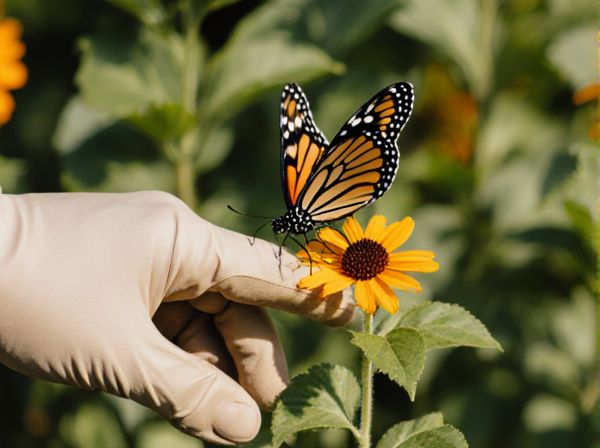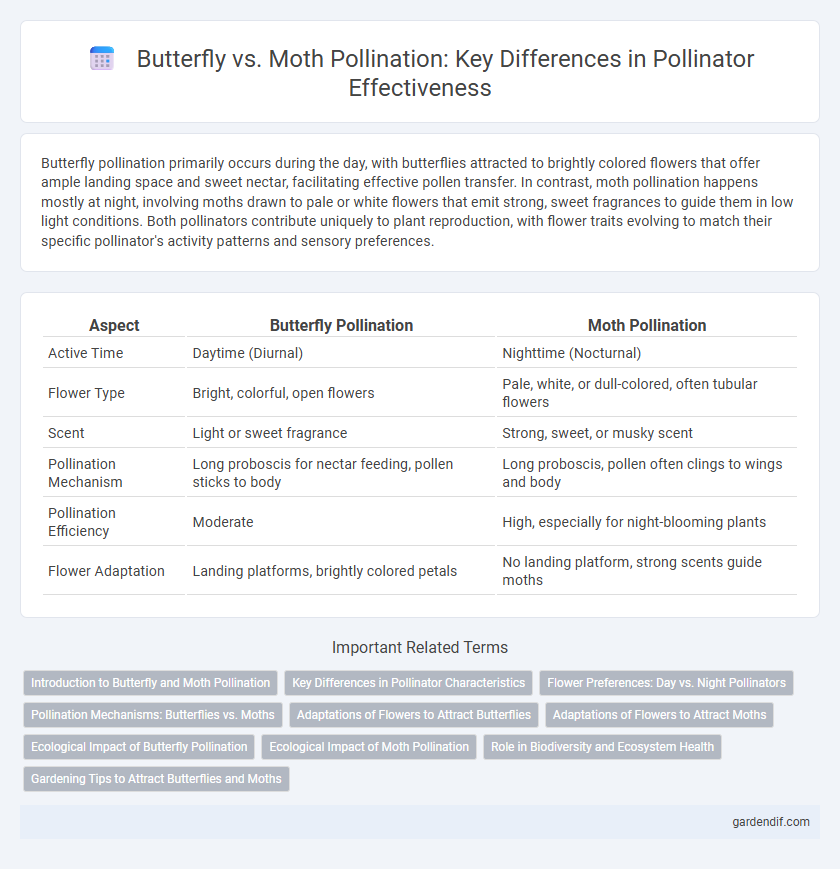
Butterfly Pollination vs Moth Pollination Illustration
Butterfly pollination primarily occurs during the day, with butterflies attracted to brightly colored flowers that offer ample landing space and sweet nectar, facilitating effective pollen transfer. In contrast, moth pollination happens mostly at night, involving moths drawn to pale or white flowers that emit strong, sweet fragrances to guide them in low light conditions. Both pollinators contribute uniquely to plant reproduction, with flower traits evolving to match their specific pollinator's activity patterns and sensory preferences.
Table of Comparison
| Aspect | Butterfly Pollination | Moth Pollination |
|---|---|---|
| Active Time | Daytime (Diurnal) | Nighttime (Nocturnal) |
| Flower Type | Bright, colorful, open flowers | Pale, white, or dull-colored, often tubular flowers |
| Scent | Light or sweet fragrance | Strong, sweet, or musky scent |
| Pollination Mechanism | Long proboscis for nectar feeding, pollen sticks to body | Long proboscis, pollen often clings to wings and body |
| Pollination Efficiency | Moderate | High, especially for night-blooming plants |
| Flower Adaptation | Landing platforms, brightly colored petals | No landing platform, strong scents guide moths |
Introduction to Butterfly and Moth Pollination
Butterfly pollination predominantly occurs during the day, with butterflies attracted to brightly colored flowers that provide ample landing space and nectar. In contrast, moth pollination takes place mostly at night, involving pale or white flowers that emit strong fragrances to attract moths. Both pollinators play crucial roles in plant reproduction, but their activity patterns and flower preferences highlight distinct ecological adaptations.
Key Differences in Pollinator Characteristics
Butterfly pollination is characterized by diurnal activity, vibrant color attraction, and long, slender proboscises suited for accessing nectar from brightly colored, tubular flowers. Moth pollination, in contrast, predominantly occurs nocturnally, with moths drawn to pale or white, heavily scented flowers that emit fragrance at night, leveraging their stronger olfactory senses. Key distinctions include butterflies' reliance on visual cues and moths' adaptation to low-light environments, which shape their respective pollination behaviors and floral preferences.
Flower Preferences: Day vs. Night Pollinators
Butterflies primarily prefer brightly colored flowers such as reds, oranges, and yellows that open during the day, utilizing their keen vision to locate nectar sources. Moths, adapted to nocturnal activity, are attracted to pale, white, or night-blooming flowers that emit strong, sweet fragrances to guide them in the dark. The distinct pollination patterns of butterflies and moths highlight the evolutionary specialization of floral traits for day versus night pollinators.
Pollination Mechanisms: Butterflies vs. Moths
Butterflies primarily pollinate during the day using their long proboscises to extract nectar from brightly colored, tubular flowers with landing platforms. Moths, active mainly at night, are attracted to pale or white, strong-scented flowers and use their feathery antennae to navigate while hovering close to the flower. The difference in sensory adaptations and activity periods drives distinct pollination mechanisms, influencing floral morphology and nectar accessibility in both butterfly- and moth-pollinated plants.
Adaptations of Flowers to Attract Butterflies
Flowers adapted for butterfly pollination exhibit bright colors such as red, orange, and pink, which cater to butterflies' keen color vision. These flowers often have flat or clustered landing platforms, providing easy access for butterflies to rest while feeding on nectar. Their sweet fragrance is generally mild and appeals to butterflies' sensory preferences during daylight hours.
Adaptations of Flowers to Attract Moths
Flowers adapted to moth pollination typically exhibit pale or white colors that are more visible in low light conditions, enhancing attraction during dusk and nighttime. These flowers often emit strong, sweet fragrances to guide moths from a distance, compensating for limited visual cues. Long, narrow floral tubes accommodate the proboscis of moths, facilitating efficient nectar access and pollen transfer.
Ecological Impact of Butterfly Pollination
Butterfly pollination significantly contributes to biodiversity by facilitating the reproduction of a wide range of flowering plants, which supports complex ecosystems. Butterflies are active during the day and often visit brightly colored, fragrant flowers, enhancing the genetic diversity of plant populations through cross-pollination. Their role in pollination helps sustain habitats for various wildlife species, promoting ecological resilience and stability.
Ecological Impact of Moth Pollination
Moth pollination plays a crucial ecological role by supporting nocturnal plant species that rely on nighttime pollinators for reproduction, thus maintaining biodiversity in night-time ecosystems. Moths often pollinate plants with pale or white flowers that release strong fragrances at night, facilitating cross-pollination and genetic diversity. This nocturnal pollination complements diurnal butterfly pollination, enhancing overall ecosystem resilience and stability.
Role in Biodiversity and Ecosystem Health
Butterflies contribute to biodiversity by pollinating a wide variety of flowering plants during the day, promoting genetic diversity and supporting ecosystems dependent on these plants. Moths primarily pollinate nocturnal flowers, filling a unique ecological niche that ensures pollination continuity and ecosystem resilience across diurnal and nocturnal cycles. Both butterflies and moths enhance ecosystem health by supporting plant reproduction, which sustains food webs and habitat diversity critical for numerous wildlife species.
Gardening Tips to Attract Butterflies and Moths
Butterfly pollination thrives in gardens with brightly colored, fragrant flowers like milkweed, zinnias, and lantanas, which bloom during the day and offer landing pads for butterflies. Moth pollination favors pale or white flowers such as evening primrose and jasmine that emit strong scents at night, attracting nocturnal moths with their nectar. Incorporate a mix of native host plants, avoid pesticides, and provide sheltered areas to create an inviting habitat for both butterflies and moths essential for effective pollination.
Butterfly Pollination vs Moth Pollination Infographic

 gardendif.com
gardendif.com